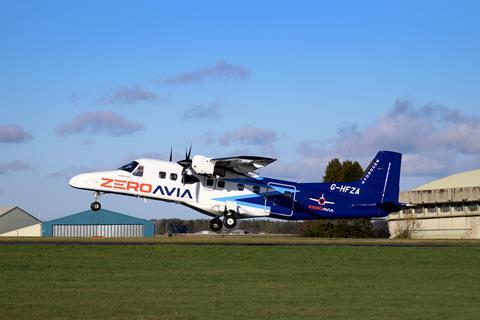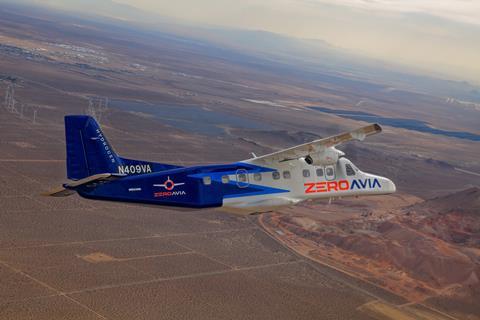Advanced propulsion developer ZeroAvia has revised the flight-test plan for its ZA600 powertrain, transferring a second Dornier Do 228 twin-turboprop to the UK in support of its certification push.
To date, the company has relied on a single modified Do 228 (G-HFZA) to perform test flights of the 500-700kW-rated ZA600 system from its Cotswold airport base in southwest England.

That aircraft has a single electric propulsion unit (EPU) installed in place of its stock port-side Honeywell TPE331 thermal engine. The powertrain’s fuel cells, hydrogen storage and batteries are located inside the fuselage.
But a second ZeroAvia-owned Do 228 – currently registered as N409VA – was ferried to the UK earlier this year, arriving at Cotswold airport on 15 June. Registration records show the aircraft was purchased by the company in 2022.
Speaking at July’s Farnborough air show, ZeroAvia chief executive Val Miftakhov told FlightGlobal that the new arrival will be used to bolster the company’s flight-test capacity.
Miftakhov says the initial Do 228 will be used to evaluate the certification-standard electric propulsion system, while its sister aircraft will perform a similar role for the power generation system (PGS) – essentially the fuel cells, hydrogen tanks and balance of plant.
“We are going to de-risk the systems separately,” he says. Flight tests of the separate systems will last for around six to nine months, before they are combined into a single production-standard powertrain aboard a Cessna Caravan – the launch platform for the ZA600.
While the new EPS will feature the latest generation of ZeroAvia’s electric motor, the PGS will use the current iteration, says Miftakhov.

ZeroAvia hopes to achieve certification for the ZA600 system towards the end of 2025, leading to service entry aboard the Caravan – via a supplemental type certificate – in mid-2026.
An initial phase of testing using the first Do 228 was wrapped up in July 2023 following a series of 10 sorties. ZeroAvia had been hoping to continue the programme this year, incorporating progressively longer point-to-point flights, but aircraft tracking data shows G-HFZA as not having flown since its 12th mission on 18 April.
Miftakhov attributes the hiatus to a mixture of technical tweaks made to the aircraft and the time needed to obtain regulatory clearance for the flights.
However, he says these hurdles have been overcome: “The aircraft is ready, the permit is there.”































